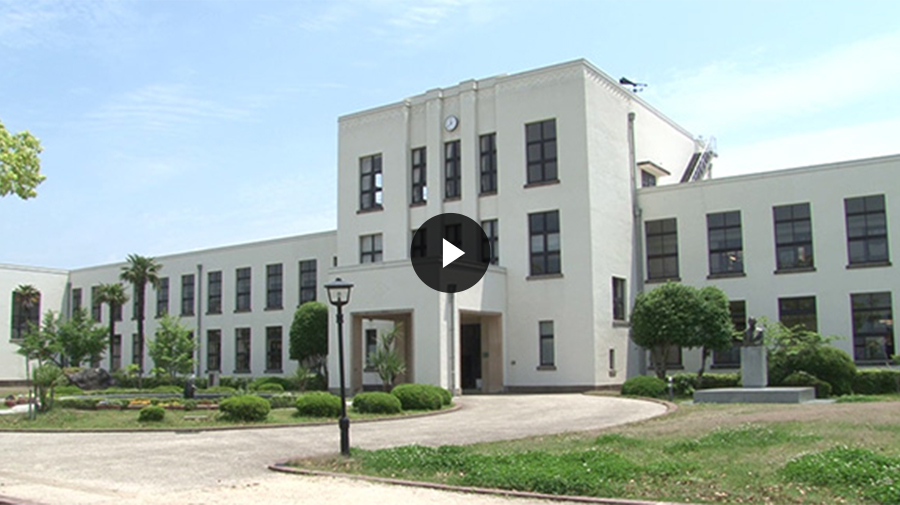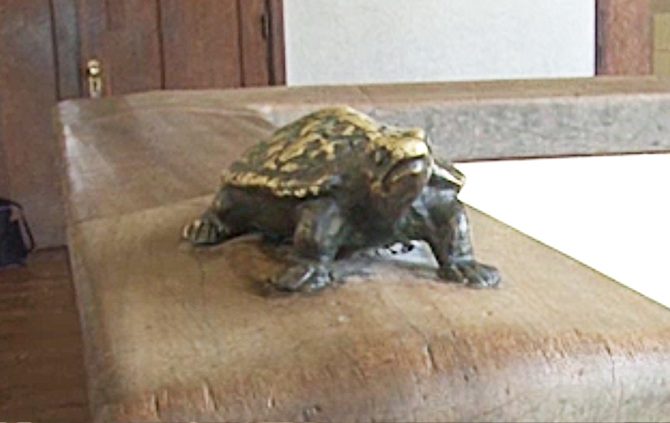Our HistoryThe Philanthropic Endeavor of an Ohmi Merchant
- The Philanthropic Endeavor of an Ohmi Merchant
- Our Roots
- Historical Photo Gallery
- Visiting the Birthplace of Marubeni - Exploring Toyosato

Tetsujiro Furukawa of Marubeni Shoten and His Dream School in Toyosato

Nakasendo, one of the ancient routes linking Kyoto and Tokyo, passes through Toyosato, a small town located in the northern part of Shiga. It was home to Tetsujiro Furukawa, who built the solid foundation of Marubeni’s trading business while serving as the senior managing director of Marubeni Shoten between 1921 and 1940. He is also known for an extraordinarily benevolent gift he has given to children of his birthplace.
Along the historic road, which was extensively reinforced during the 17th century, are traditional Japanese wooden houses partly painted with Bengala or red colcothar, a pigment long used in Japan to prevent aging damage. Within these surroundings nestles an imposing, snow-white concrete building. Built in 1937, the Western-style structure stands on a large tract of land—the remains of the old Toyosato Elementary School. In the middle of a pond built in its front yard sits a fish fountain.

The school was relocated in 2004 to a new building across the main yard, but the old building, which has become a “registered tangible cultural property,” continues to be utilized by the local community. It houses a library, a day care center, and the Toyosato board of education.
Principles of Ohmi Merchants
Furukawa learned business with the Itoh family, and before long, he was showing great potential. He became the general manager of Itochu Shoten at a young age. Later at Marubeni Shoten, which was established in 1921, he introduced a variety of modern business operations such as credit management and budget management. Furukawa almost singlehandedly transformed Marubeni into a resilient company.
“Tetsujiro Furukawa’s principles of management boil down to the practicing of what the Ohmi Merchants came to realize as their core values; ‘secret benefaction’ and ‘considering the interests of the seller, the buyer, and the society,’” said Dr. Hideki Usami of Shiga University, an expert in the history of commerce. “Throughout his career, Furukawa pursued a way of doing business, which would also benefit the customers. That is, making deals in accordance with their financial health while never acting in a way that would ruin their businesses.”
Historically speaking, the Ohmi Merchants are generally defined as successful traders of the Edo period (1603-1867), who were natives of Ohmi, the northeast region of Shiga. They were known for their ability to build successful businesses in places away from their home base. In fact, the roots of many of Japan’s leading companies today lead back to the Ohmi Merchants.
The Tortoise and The Hare
An accomplished businessman and compassionate citizen, Furukawa donated a large proportion of his wealth to the building of a sound future for children. He commissioned an American architect, William Merrell Vories, to give shape to his philanthropic endeavor. Vories, a devoted Christian missionary, came to Shiga in 1905 as an English teacher and later became an architect and entrepreneur.
Some of the striking features of Vories’ design for the Toyosato Elementary School include high ceilings and large glass windows that are situated along the face of the building. The long and spacious corridor is about 3m wide. Abundant natural light poured into the classrooms, reducing the need for electric lighting.
The real trademark of the old building, however, is the brass objects—tortoises and hares—that are placed on the handrail along the staircase to the third floor. They are there to narrate a race between the two. Reportedly, a childhood memory, which reminded him of “The Tortoise and the Hare,” came to Furukawa’s mind when Vories proposed making a school symbol.
The little Furukawa had often attracted bullies because of his slowness. On the day he completed his elementary course, his teacher gave him inspirational advice.
“Keep working hard even when no one is watching,” the teacher said, referring to the Aesop fable. “It doesn’t matter if your pace is slow. It’s more important that you keep moving forward.”
Unlike his elder brother, who was smart and sociable, the little boy had to abandon his dream of acquiring higher education. His parents were working around the clock selling oil to make ends meet and feed their many children. Furukawa left home at the age of eleven and began his apprenticeship in Osaka under his uncle, Chubei Itoh.
Building a Dream School

Furukawa wanted to expand his horizons further. He joined his younger brother Yoshizo to go on a 7-month tour to visit the US and Europe. In his book, “A Peep Into the Lives of Peoples—A Record of my Travels Around the Globe,” Yoshizo Furukawa wrote about the factories and department stores they visited, where his brother was impressed by their productive operations and efficient management.
During their stay in the US, the Furukawa brothers were most profoundly inspired by Stanford University, which was founded on the philanthropy of Leland Stanford, a railroad tycoon, and his wife Jane. They donated an immense amount of money to build an educational institution as a memorial for their beloved son, who died very young.
Yoshizo wrote that the Japanese should follow the example of the Stanfords in seeking altruistic means of spending money. “While a number of people have made a fortune, few people have dispensed their wealth in a sensible manner,” he wrote. “Wealthy individuals in Japan blindly stick to the idea of preserving the wealth they created by passing it on to their children. As a consequence, their heirs will become frivolous squanderers.”
The legacy of the Stanfords struck a chord in Tetsujiro Furukawa, who had embraced the key principle of the Ohmi Merchants: The money you made in society should be plowed back into society. Furukawa was galvanized into action. In order to build his ideal school, he purchased a piece of land and paid all of the construction costs out of his own pocket.
“Furukawa believed that the school should be built in the most ideal way,” Dr. Usami explained. “So, he took this stance: ‘I want to leave it entirely in the hands of an expert, who can do that. I will never interpose myself into the project.’”
The tortoises and hares are laid out along the handrail of each stairway, reproducing the scenes from the fable. The tortoise, our protagonist, who can only take a small, slow step at a time, moves up the handrail as he continues to look up at the hare ahead of him. The brass tortoises have become mottled with green under the touch of many small hands over the years.
Finally passing the sleeping hare at the top of the handrail, the tortoise admires the spectacular view through a large window.
